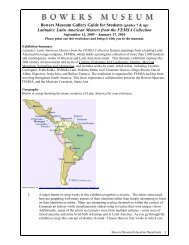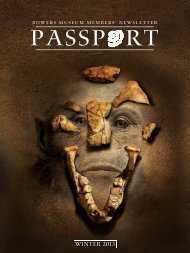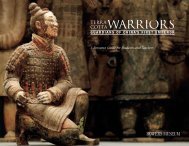Secrets of the Silk Road – Teacher Packet - Bowers Museum
Secrets of the Silk Road – Teacher Packet - Bowers Museum
Secrets of the Silk Road – Teacher Packet - Bowers Museum
You also want an ePaper? Increase the reach of your titles
YUMPU automatically turns print PDFs into web optimized ePapers that Google loves.
POST-VISIT ACTIVITIES<br />
Below are a couple <strong>of</strong> activities you can go over with your students after <strong>the</strong> seeing exhibition.<br />
POST-VISIT ACTIVITY 1: WALK IN THEIR SHOES<br />
Based on what you know <strong>of</strong> <strong>the</strong> <strong>Silk</strong> <strong>Road</strong>, and what you learned while at <strong>the</strong> museum, imagine you<br />
are a traveler on <strong>the</strong> <strong>Silk</strong> <strong>Road</strong>. Trace your journey with one <strong>of</strong> <strong>the</strong> objects you saw. Who are you?<br />
Are you a trader or simply a traveler? Where did you begin your journey? Where are you going?<br />
How did you travel? Where did <strong>the</strong> object you are carrying originate from? Where did it end up?<br />
Think about what it would have been like to travel <strong>the</strong> <strong>Silk</strong> <strong>Road</strong> at various points during its history,<br />
and write a page discussing <strong>the</strong> above questions.<br />
POST-VISIT ACTIVITY 2: EAST AND WEST -- THE EXCHANGE OF CULTURE AND<br />
IDEAS ALONG THE SILK ROAD<br />
During <strong>the</strong> exhibition, you saw a lot <strong>of</strong> things that may not have actually originated in China where<br />
<strong>the</strong>y were found. What are some <strong>of</strong> <strong>the</strong> things o<strong>the</strong>r than silk that were exchanged along <strong>the</strong> <strong>Road</strong>?<br />
(Hint, you learned about some <strong>of</strong> <strong>the</strong>m during one <strong>of</strong> <strong>the</strong> pre-visit activities, and you may have even<br />
seen some <strong>of</strong> <strong>the</strong>m at <strong>the</strong> <strong>Museum</strong>!)<br />
What is one major religion that gained popularity as a result <strong>of</strong> merchants traveling from place to<br />
place and culture to culture? Where did this religion begin? Where is it practiced today? (See object<br />
below for hint)<br />
Wooden Buddhist Sculpture, 3rd-4th Century<br />
<br />
Excavated from Niya<br />
Xinjiang Institute <strong>of</strong> Archaeology Collection<br />
H: 64cm W: 18cm Thickness: 9cm<br />
(Set: 2 items)<br />
H:25.6” W:7.2”<br />
Thickness:3.6”<br />
<strong>Bowers</strong> <strong>Museum</strong> Education Department<br />
March 2010<br />
On both sides <strong>of</strong> <strong>the</strong>se rectangular blocks <strong>of</strong> wood are standing figures carved<br />
in bas relief with one arm raised and <strong>the</strong> o<strong>the</strong>r resting on <strong>the</strong> hip. The facial<br />
features, fingers, and clo<strong>the</strong>s are outlined in ink. Each figure has its hair tied<br />
up in a chignon and wears a close-fitting top with a round collar and a long<br />
skirt. On <strong>the</strong> lower abdomen <strong>the</strong> re are four impressions that look like <strong>the</strong>y<br />
might be fingers. This group <strong>of</strong> sculptures is generally believed to be<br />
Buddhist art. The area surrounding where <strong>the</strong>se sculptures were discovered<br />
also had remains <strong>of</strong> a Buddhist temple and government <strong>of</strong>fices. This<br />
discovery reflects <strong>the</strong> influence <strong>of</strong> Buddhism on <strong>the</strong> secular lives <strong>of</strong> <strong>the</strong> Niya<br />
people.<br />
18





